MOTOCROSS ACTION’S TWO-PART TUESDAY (MORE ACCURATELY, PART ONE ON TUESDAY AND THE SECOND PART IN THE MID-WEEK REPORT ABOVE):
By: Zap
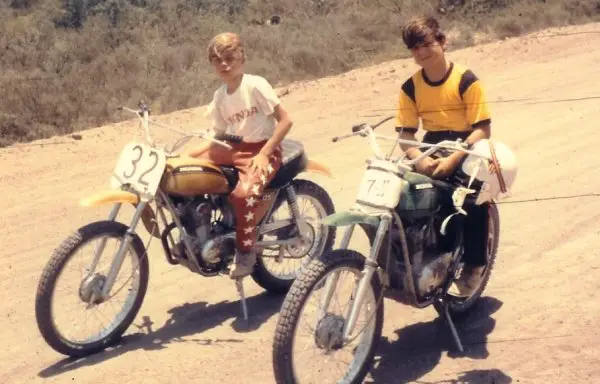
There was a time when a rider could be competitive on a Honda SL125. Steve, on the right, race one in the local Texas scene in 1973.
Steve Wise was motorcycle racer in Texas who somehow parlayed his motocross talents into a career that included major victories as a dirt tracker and road racer. In simple terms, there’s never been another racer who has achieved the level of success that Steve did across a wider swath of motorcycle disciplines.
Born in McAllen, Texas, 54 years ago, Steve was a lot like so many other kids in the 1970’s who got his start in the sport by first attending the races with his father. Besides being a motocross fan in his own right, Steve’s dad also happened to own a motorcycle shop. For Steve it was a Trans-AMA race in Rio Bravo, Texas, in 1973 that got him intrigued by riders with very un-Texan sounding names like DeCoster and Geboers.
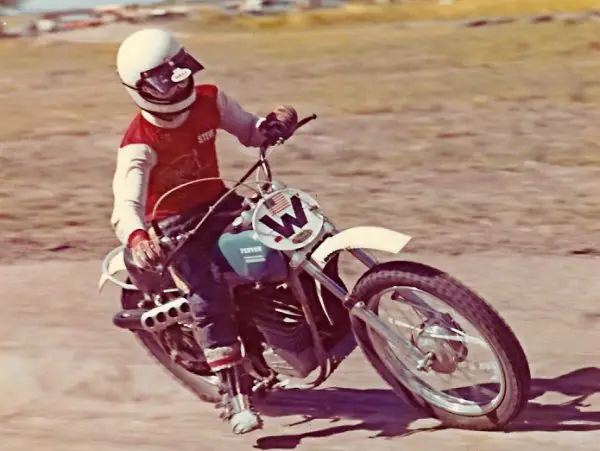
Steve and his beloved Penton. His dad became a Penton dealer so Steve could race the Penton.
“I had an idea that I’d be racing those guys some day and after my minibike days I started down that path when I got my first real bike?a Honda SL125. In fact, I won my first race on that bike and from there it just took off. My dad and I would drive to races all over Texas, which was not easy since everything was so spread out. When it became apparent that the Honda four-stroke wasn’t going to be competitive, my dad decided to become a Penton dealer to get me on one of those bikes. It transformed my career! In fact, when I got inducted into the AMA Motorcycle Hall of Fame John Penton was in the audience and I made sure to thank him for his bikes.
“By the time I was 16 I entered the 1974 Tex-AMA on a Honda CR250 and beat guys like Gary Jones and Jimmy Weinert. We figured that if I could do that good before I’d ever raced a National that we should hit some AMA races. Later that year we traveled to New Mexico, New York, for my first AMA National ? it was a rude awakening! Even though I finished eighth overall, I got lapped. I couldn’t believe it. I found out that for guys like Weinert, racing the Tex-AMA series was for fun. But, in New York, he was serious. We headed to the next round in Delta, Ohio, after that and again I had a top ten finish, but I was way off the pace and got smoked.”
THE FACTORY COMES CALLING – TWICE
“Kawasaki was hiring riders and they called Steve Stackable, but he had already been hired by Maico, so he gave them my name. I’ll never forget that day. I was sitting at home after Thanksgiving and the phone rang with Kawasaki’s Tim Smith on the line. They ended up flying my dad and I out to California where I raced a works bike at a local race at Carlsbad. That was another rude awakening ? those local boys, like Gaylon Moisier, could fly! But Kawasaki was still impressed with me and gave me a ride.
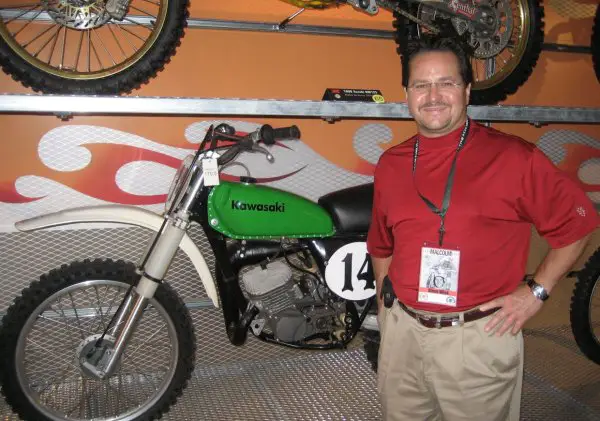
Steve visits his Kawasaki works bike at the Motorcycle Hall of Fame museum.
“The plan was to race the 125 Nationals in 1975. I had Jim Felt as my mechanic. The bike they brought over from Japan was beautiful, but it was so slow. I scored a few top- five finishes, but then Kawasaki pulled out of the AMA Nationals with budget problems.
“For the San Antonio, Texas, round I raced a Honda CR125 right off my dad’s showroom floor. It had an FMF pipe, some Girling shocks, a 30mm carb and porting by my mechanic Jimmy Strait. Granted, it was my home track, but I led Marty Smith for most of the first moto and got second overall on a $600 stocker versus their $30,000 works bikes. At the New Orleans round I got fifth overall and, at the end of the season, Kawasaki called me back to apologize and offered me a ride for 1976. That was my #14 KX250 ? another beautiful bike that unfortunately was once again, so, so, slow. I was getting paid $1500 a month with expenses, but I just couldn’t do a repeat of the year before it so I called Kawasaki and quit.
“The next thing I know Terry Mulligan from Team Honda calls. They needed help against Bob Hannah so they flew me to the Buchanan National for a try-out. All they had for me to ride was a junkie practice bike with no mechanic, so I spent all day Saturday working on the bike and then raced it on Sunday and got third overall.”
THE DAY IT ALL CHANGED
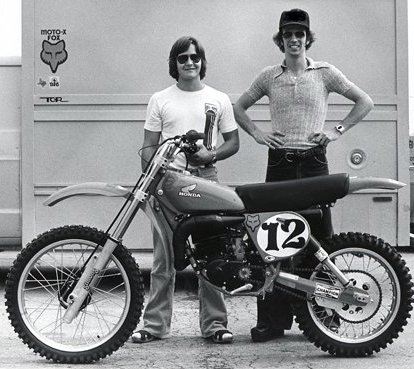 “It was on July 4 at the AMA National at Kaiser Ridge, Maryland, that I had a perfect storm of a day. I was back on my own CR125 with Jimmy Strait as my mechanic. I holeshot the first moto and was leading until Marty Smith finally went by. I knew he was faster than me so I decided to save as much energy as possible for the second moto. Well, I pulled another holeshot and at the halfway point Jimmy gave me the same signal, ‘Smith coming.’ He caught me on the last lap, but this time I wasn’t pulling over. I figured I didn’t come that far just to get beat so I started blocking him. Whenever I felt him trying to make a pass I’d ride in the middle of the track?whichever side he tried to come around on I would move over on him. It worked and I became the first privateer to win a 125 National.
“It was on July 4 at the AMA National at Kaiser Ridge, Maryland, that I had a perfect storm of a day. I was back on my own CR125 with Jimmy Strait as my mechanic. I holeshot the first moto and was leading until Marty Smith finally went by. I knew he was faster than me so I decided to save as much energy as possible for the second moto. Well, I pulled another holeshot and at the halfway point Jimmy gave me the same signal, ‘Smith coming.’ He caught me on the last lap, but this time I wasn’t pulling over. I figured I didn’t come that far just to get beat so I started blocking him. Whenever I felt him trying to make a pass I’d ride in the middle of the track?whichever side he tried to come around on I would move over on him. It worked and I became the first privateer to win a 125 National.
“The 1976 season was a great year. It was America’s Bicentennial and Hannah had arrived on the scene, I finished fifth overall at the Mid-Ohio 125 GP as the only privateer in the top ten and I ended up fourth overall in the 125 Nationals.
“Over the winter though, Honda didn’t call and I was pretty disappointed. But, then I got a call from a guy named Cliff White who was putting a team together for an aftermarket company called CH Industries. I took the ride, but then CH pulled out, so I called Fox who was also putting together a team with Mark Barnett and Pat Richter. I didn’t get a salary, but Fox paid my expenses and my dad bought the van. Cliff White came with me and built a beautiful bike that I rode to a fifth overall Hangtown, but it didn’t stay together too well. Honda gave us a Mugen top end and it was awesome ? I was a real runner after that partner!
“I have to say, riding for the Fox brothers was a real treat. Even though I wasn’t getting paid, I always felt like they were committed to me and the team. They were so passionate and proactive ? they never thought we couldn’t beat the factory guys. They believed in us as riders and they were committed to the technology as well. As privateers everything was so hands-on back then. I remember hanging out in Steve Simon’s shop at 2:00 am the day before Hangtown while he was milling me a new steering stem so I could run his forks. Trying to develop equipment to beat the factory bikes was what it was all about for us.
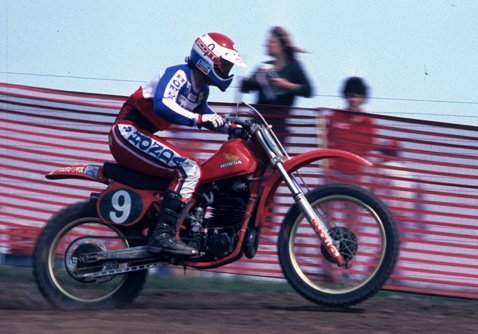
“The 1980 season was the year I really felt like I had the “eye of the tiger.” We had the new works bikes with the Pro-Link suspension and I had Paul Turner as my mechanic. Turner was a real mechanic and he was the guy who took the radiators of the ’81 bike and re-positioned them down low, which made the bike work so much better. Unfortunately, I got hurt, so the bike went to Donnie Hansen. Overall, that was they year I thought I could have won the Supercross title, but between some mechanical bad luck and my knee injury, it just didn’t work out.”
LOOK FOR PART TWO OF THE STEVE WISE STORY IN THIS WEEK’S MID-WEEK REPORT
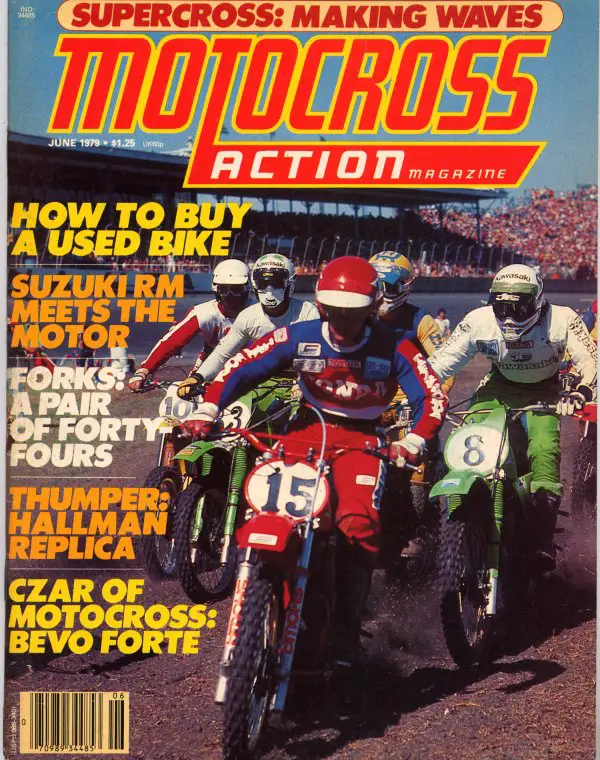
Steve leads the way at Daytona for the June 1979 cover of MXA.





Comments are closed.